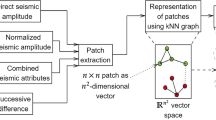Abstract
Structural interpretation tasks require the step of fault segmentation, which is mostly performed manually, in seismic samples. Recent approaches represent seismic samples as 3D images and utilize a variety of methods, including Deep Learning. In this research, the authors propose a 3D bi-stream convolutional neural network, derived from U-Net, as an end-to-end model to segment seismic faults. Empirical results prove the power of the 3D bi-stream U-Net whose accuracy reaches 96.30% which outperforms recent works. The proposed network is potential for practical applications in seismic data analysis.
Access this chapter
Tax calculation will be finalised at checkout
Purchases are for personal use only
Similar content being viewed by others
References
**nming, W., Liang, L., Shi, Y., Fomel, S.: FaultSeg3D: using synthetic datasets to train an end-to-end convolutional neural network for 3D seismic fault segmentation. Geophysics 84(3), 35–45 (2019)
TensorFlow: Large-Scale Machine Learning on Heterogeneous Systems. http://www.tensorflow.org/
Prechelt, L.: Early stop** — but when? In: Montavon, G., Orr, G.B., Müller, K.-R. (eds.) Neural Networks: Tricks of the Trade. LNCS, vol. 7700, pp. 53–67. Springer, Heidelberg (2012). https://doi.org/10.1007/978-3-642-35289-8_5
Bisong, E.: Google colaboratory. In: Building Machine Learning and Deep Learning Models on Google Cloud Platform: A Comprehensive Guide for Beginners, pp. 59–64, Apress, Berkeley, CA (2019). https://doi.org/10.1007/978-1-4842-4470-8_7
**nming, W., Zhu, Z.: Methods to enhance seismic faults and construct fault surfaces. Comput. Geosci. 107, 37–38 (2017). https://doi.org/10.1016/j.cageo.2017.06.015
**nming, W., Fomel, S.: Automatic fault interpretation with optimal surface voting. Geophysics 83, 067–082 (2018). https://doi.org/10.1190/geo2018-0115.1
Wu, J., Liu, B., Zhang, H., He, S., Yang, Q.: Fault detection based on fully convolutional networks (FCN). J. Marine Sci. Eng. 9(3), 259 (2021). https://doi.org/10.3390/jmse9030259
Cohen, I., Coult, N., Vassiliou, A.A.: Detection and extraction of fault surfaces in 3D seismic data. Geophysics 71, 021–027 (2006). https://doi.org/10.1190/1.2215357
Ronneberger, O., Fischer, P., Brox, T.: U-Net: convolutional networks for biomedical image segmentation. In: Navab, N., Hornegger, J., Wells, W.M., Frangi, A.F. (eds.) MICCAI 2015. LNCS, vol. 9351, pp. 234–241. Springer, Cham (2015). https://doi.org/10.1007/978-3-319-24574-4_28
He, K., Zhang, X., Ren, S., Sun, J.: Deep residual learning for image recognition. In: CVPR (2015). http://arxiv.org/abs/1512.03385
Author information
Authors and Affiliations
Corresponding author
Editor information
Editors and Affiliations
Rights and permissions
Copyright information
© 2022 The Author(s), under exclusive license to Springer Nature Singapore Pte Ltd.
About this paper
Cite this paper
Van-Ha, T.D., Thanh-An, N. (2022). 3D-FaultSeg-UNet: 3D Fault Segmentation in Seismic Data Using Bi-stream U-Net. In: Dang, T.K., Küng, J., Chung, T.M. (eds) Future Data and Security Engineering. Big Data, Security and Privacy, Smart City and Industry 4.0 Applications. FDSE 2022. Communications in Computer and Information Science, vol 1688. Springer, Singapore. https://doi.org/10.1007/978-981-19-8069-5_32
Download citation
DOI: https://doi.org/10.1007/978-981-19-8069-5_32
Published:
Publisher Name: Springer, Singapore
Print ISBN: 978-981-19-8068-8
Online ISBN: 978-981-19-8069-5
eBook Packages: Computer ScienceComputer Science (R0)




